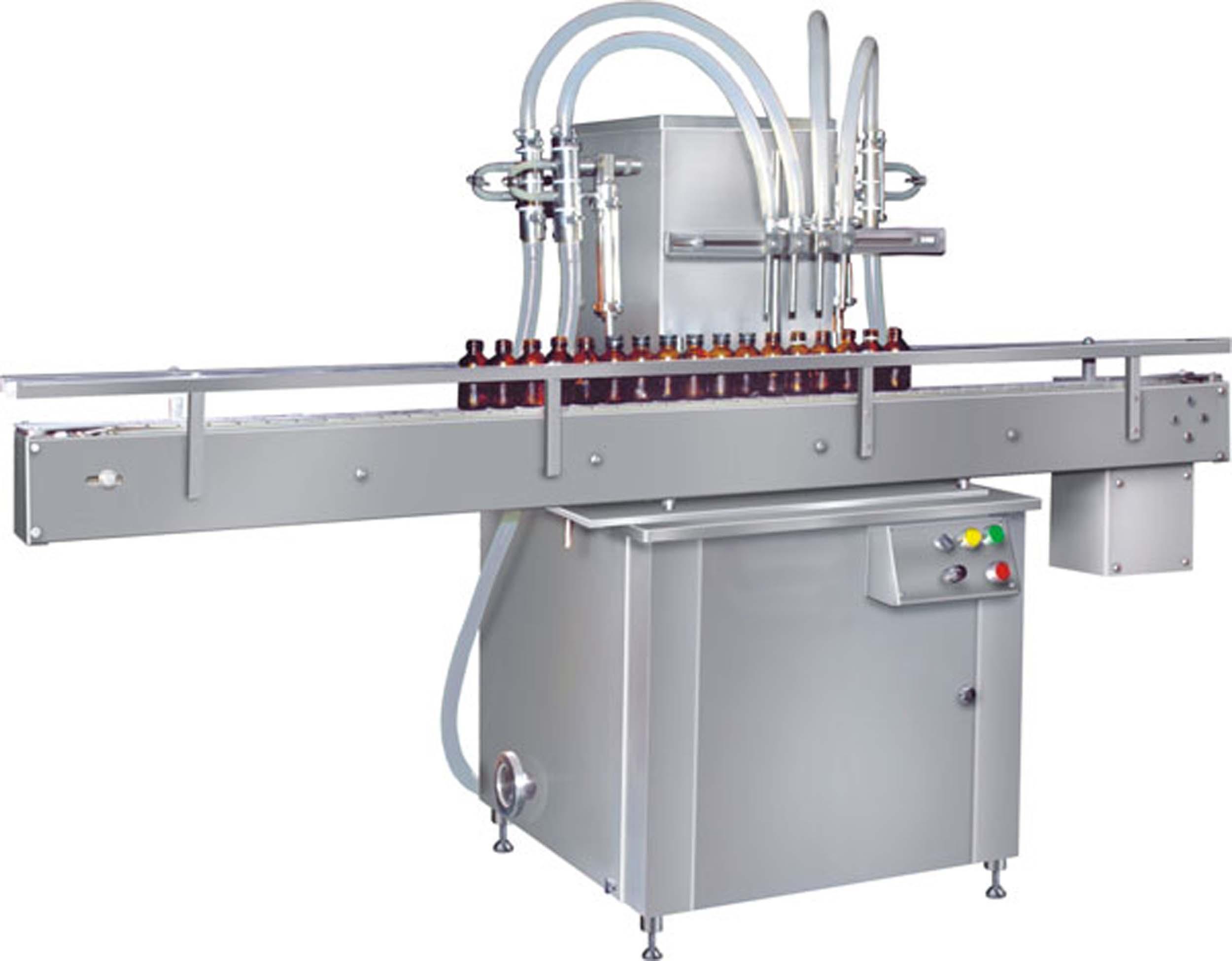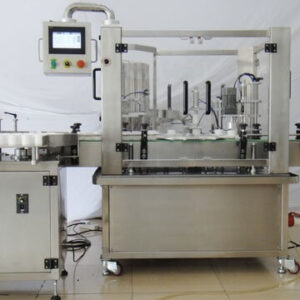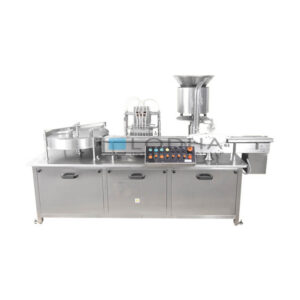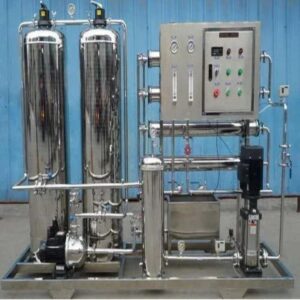Description
The semi-automatic bottle-filling machine is a versatile industrial machine designed for efficiently filling containers of different viscosities with liquids. It’s a quick way to get those bottles, jars, or cans filled accurately and consistently while still being able to have some control over the job manually. It is used in industries like food and beverage, pharmaceuticals, cosmetics, and chemicals.
Typically, the semi-automatic bottle filling machine has a conveyor belt or rotary table where containers are placed, a filling mechanism, and controls for adjusting various parameters such as volume and speed of fillings. Depending on its model it may use a gravity feed system, piston type, or vacuum-based filler designed to match precisely the product in question that’s being filled.
This machine has several benefits including higher production rates compared to manual methods of bottle filling. Also, it reduces labor costs by automating most of the process while maintaining high levels of precision required when using other methods. Besides this, its structure is not so rigid making it flexible enough to be applied in sizes or shapes of different pots hence suitable for small- medium-scale manufacturers.
In general, the semi-automatic bottle-filling machine fills all kinds of liquid products into tubes with efficiency, accuracy, and versatility.
Understanding Semi Automatic Bottle Filling Machines
Automation Balance
Semi-automatic bottle fillers are very versatile machines built purposely to do their work effectively on liquid bottles. They offer less automation than fully automated equipment but more than what would be obtained from manual processes. This makes them very useful in many sectors since they can satisfy diverse manufacturing needs from one industry to another.
Core Components
The key parts that make up any semi-automatic bottle-filling machine include container placement systems such as conveyor belts or rotary tables; fillers units; and user-friendly interfaces that facilitate adjustment of settings like volume rationing per second among others. For instance, gravitational feed systems are employed here depending on different applications such as; piston-type, vacuum-based fillers to ensure accurate filling of products.
Advantages of Semi-Automatic Bottle Filling Machines
Better Efficiency
The major advantage of these machines is that semi-automatic bottle-filling machines can help to increase productivity. By automating the process of filling, it eliminates most labor and time compared to traditional manual methods. The line operators are therefore left with only one task which is monitoring the process while at the same time performing other duties thus increasing their production capacity.
Cost Effective
Semi-automatic filling equipment is cost-effective because it reduces labor costs. Although initial investments in these machines’ specifications vary, long-term savings on human resources and increased efficiency justify this expenditure. Moreover, such equipment can be adjusted to fit a wide range of different containers to minimize multiple machine usage hence lowering overall expenses incurred herein.
Better Accuracy
Precision matters when dealing with liquid products during manufacturing processes. Semi-automatic bottle-filling machines are best for such purposes since they give consistent fills so as not to waste any product from one batch compared to another. Also, they have good controls that allow settings adjustments aimed at ensuring top-notch quality standards are met without much difficulty.
Applications of semi-automatic bottle filling machine
1. Food and Beverage Industry
In the food and beverage industry, semi-automatic bottle-filling machines play a crucial role in filling containers with different types of liquid products. It does not matter if it is packaging sauces, dressings, oils, or preparing beverages such as juices, soft drinks, or spirits; these machines guarantee that the filling is made precisely and hygienically. They are capable of working with diverse viscosities and sizes of bottles; this makes them suitable for a wide range of food and beverage applications.
2. Pharmaceutical Industry
When it comes to pharmaceutical manufacturing, accuracy, and compliance are vital factors that semi-automatic bottle-filling machines meet satisfactorily. These machines fill vials, bottles, and ampoules with liquid medicines like syrups or oral solutions. They can help maintain the integrity of a product while still meeting regulatory requirements through some features like sterile environments used during the process of refilling and accurate dosing mechanisms.
3. Cosmetics and Personal Care Industry
Cosmetic presentation and consistency are key to customer satisfaction within the cosmetic production sector. Such devices are therefore used to fill cream jars, shampoo bottles, lotion dispensers as well as other cosmetic formulations. These equipment have adjustable filling parameters and accurate discharge which ensures uniform distribution thereby improving brand image besides also making it more attractive to consumers.
4. Chemical Industry
Semi-automatic bottle-filling machines incorporating corrosion-resistant materials alongside sturdy constructions are purposefully designed for chemical processes. Filling liquids such as cleaning agents solvents adhesives specialty chemicals can make use of these particular machines which ensures accurate spigots while reducing exposure risks.
5. Household And Cleaning Products
Packaging activities in manufacturers dealing with home appliances among other cleaning agents prefer employing semi-automatic bottle-filling filling mainly because they can be easily programmed to work efficiently. A good example of what these devices do is pack cleaner detergents inside their cans after completion then send them off for sale afterward you will find one’s dry or wet the next day. In this respect, constant level fills and high throughput are necessary for these systems.
6. Automotive And Industrial Applications
Automotive and industrial sectors also use semi-automatic bottle-filling machines. This means that such devices are capable of pouring lubricating oils, coolants, hydraulic liquids, and other automotive/industrial fluids into their respective containers. The process of dispensing smaller quantities effectively thus reducing wastage in automotive workshops as well as factories within the industry.
Functionalities Of Semi Automatic Bottle Filling Machine
1. Container Handling
Possibly the most important function of semi-automatic bottle-filling machines is container handling. They possess conveyor belts, rotary tables, or any other kind of mechanism that positions containers to be filled efficiently. This makes them versatile in that they can handle containers of different sizes, shapes, and materials starting from bottles and jars right down to vials and ampoules. This flexibility ensures that there is no constraint on production setups and manufacturers can process different kinds of containers with ease.
2. Filling Mechanism
The filling mechanism is at the heart of a semi-automatic bottle-filling machine: it fills liquid products into containers precisely & accurately. Different product natures as well as desired fill levels determine which method is applied for filling. Among the popular ones include gravity filling, piston filling, and vacuum filling among others. Gravity filler uses the force of gravity to fill overhead reservoirs while piston felling employs piston-driven pumps to dispense level amounts of liquids Vacuum felling removes air from the container before fitting to avoid foaming or spillage events These systems permit viscosity adaptation and liquid flow variation hence ensuring uniformity in terms of fill during production across different batches.
3. Control Systems
Semi-automatic bottle-filling machines have easy-to-use control systems where operators set parameters for their filling actions as well as monitor how it goes on these control panels have user-friendly interfaces complete with digital displays plus buttons used for inputting settings like fill volumes, filing speeds, container indexation, etc Advanced forms may also feature programmable logic controllers (PLCs) for automated control and recipe management thereby making it easier customizing almost every kind of a known filling application Also fine-tuning such parameters mean precise product fills which meet quality standards whilst minimizing product losses on wastage grounds.
4. Safety Features
Safety should be the top priority in any industry setting including when using semi-automatic bottle-filling machines. Different safety features are incorporated into these machines to protect operators and avoid accidents resulting from their operations. Such may include safety interlocks, emergency stop buttons, and guarding that keeps the moving parts inaccessible when in use Besides, there can be sensors coupled with alarms to detect abnormalities like container jams or overfills thereby warning attending personnel to take immediate responsive measures In this way, they make sure safe working places minimizing chances of injuries or equipment damages.
5. Maintenance and Cleanliness
For semi-automatic bottle-filling machines to last long and operate efficiently, proper maintenance and cleaning are critical. In particular terms of design, they offer easy to reach by having detachable parts plus cleanable surfaces such as those for lubricating purposes inspecting them visually inspection replace It is also possible that some have self-cleaning functions or sanitation protocols ensuring no contamination of products GCA As a result, automatic bottle fillers facilitate the process of maintaining them thus minimizing downtimes whilst ensuring steady output at all times.
FAQs
1. What kind of liquids can semi-automatic bottle-filling machines fill?
Water, juices, sauces, oils, pharmaceutical liquids, chemicals, and cosmetics are some of the various types of liquids that these machines can handle.
2. What are some advantages of using a semi-automatic bottle-filling machine?
Advantages include increased productivity; reduced labor costs; better accuracy and consistency in filling; versatility in handling different container sizes and shapes and compliance with quality standards.
3. Can Semi-automatic Bottle Filling Machines Handle Different Sizes And Shapes Of Containers?
Yes, they are designed to operate within different container sizes and shapes from bottles and jars to vials and ampoules hence allowing for flexibility in production setups due to adjustable settings.
4. What Are The Filling Methods Used In Semi-Automatic Bottle Filling Machines?
Common ones include gravity filling, piston filling, and vacuum filling among others. Gravity filling makes use of gravity force to fill up containers while piston-filling and vacuum-filling employ piston-driven pumps and vacuum chambers respectively to dispense accurate volumes of liquids.
5. How can I adjust my semi-automatic bottle filing parameters?
Using user-friendly control panels containing digital displays and buttons or switches through which operators could easily change settings such as volume (in terms of weight), and speed (flow rate) for filing or container indexing process is enabled by the operator’s panel provided with digital screen displays along with two or three buttons plus computer software system whereas programmable logic controller systems might also form part of certain systems.
6. Can I clean them easily?
These products have been made for accessibility purposes whereby removal parts accompany them hence facilitating their easy cleaning concerning this credential while regular maintenance activities like lubrication need to be done to minimize downtime.
7. What Safety Features Are Included In Semi-Automatic Bottle Filling Machines?
Safety interlocks, emergency stop buttons, guarding around moving parts, and container jams are all examples of safety features in these machines that ensure a safe working environment.
8. How do I choose the right one for my production needs?
When choosing a machine, factors such as the type of liquid to be filled, production volume required, container specifications needed, and budgetary constraints should considered. You can seek advice from manufacturers or industry consultants to get guidance on what suits you best based on your requirements.





